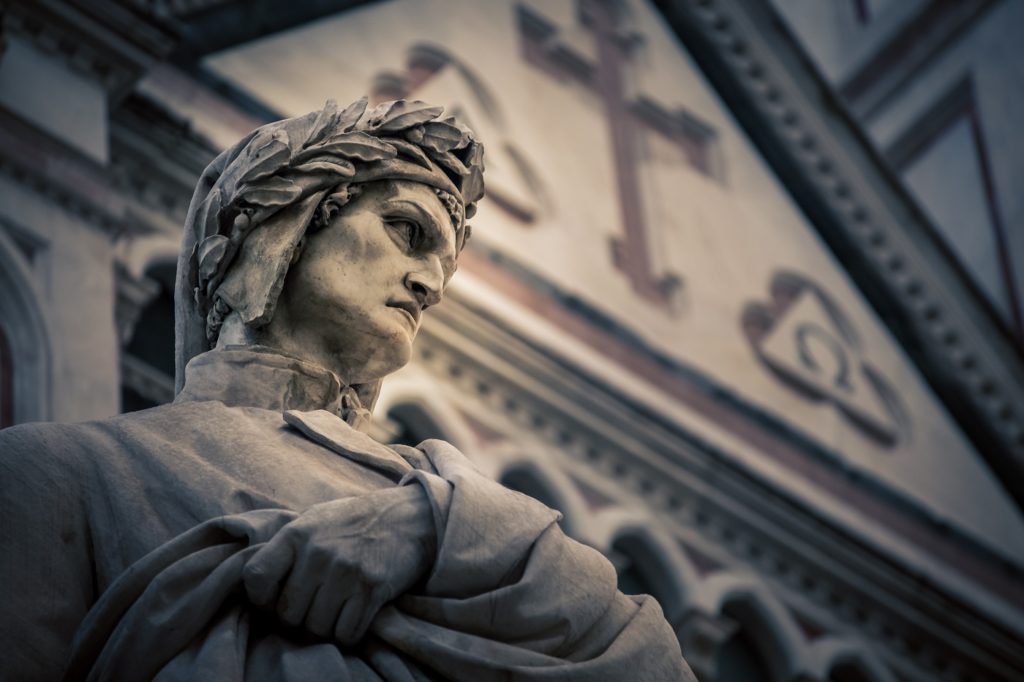Just over three weeks ago, Scott Crider published an essay here at Public Discourse about the writing of a man who died precisely seven centuries ago today, offering a compelling case for applying a pedagogical lens to Dante’s tale of the hereafter. However, among his learned observations lies a single sentence—parenthetical though it was—to which, with great respect, I take some exception.
Crider wrote:
Teaching the Inferno alone is such a curricular perversion I hardly know how to be tolerant: no wonder generations of college graduates think of Dante as a cruel tormentor, and Christianity as all judgment and no love.
As one guilty of such curricular perversion myself—having taught the Inferno, without Purgatorio or Paradiso, last spring—I hope, over the course of this small piece, to induce a measure of tolerance for those who chose to end their expedition at the edge of Dante’s hell.
Start your day with Public Discourse
Sign up and get our daily essays sent straight to your inbox.It is true that the Inferno is far more grisly than the upper rungs of Dante’s postmortem landscape. That, in part, explains its appeal to readers in almost every place and almost every age since its publication. Hell’s nine circles are populated by a haunting array of sadistic wardens and their criminal prey. We read of the three-headed Cerberus slashing at the skin of the gluttonous as they roll in the dirt and rain; we meet sinners transfigured into trees as hounds tear at their leaves and feet; we meet tyrants seething in streams of blood as pugnacious centaurs prowl the banks; we see devils whipping panders, snakes striking thieves, lead-laden hypocrites, and immobilized bodies in the silent bowels of Satan’s frozen lair, as he grinds the three greatest traitors of all time between his stained and jagged teeth.
These are just a few of the figures and scenes that have lent the first installment of Dante’s poem its longevity. They have inspired rides on Coney Island and plotlines in Dan Brown’s Inferno, speaking to the morbid curiosity that we each possess, albeit to varying degrees. A picture is indeed worth a thousand words. While Dante’s Purgatory and Paradise are peppered with memorable personalities and episodes, none compares to the graphic feast of his gruesome hellscape. I myself confess that my losing forty pounds since March is due, at least in part, to the recurring thought of the gluttons’ ghastly fate in the Inferno’s third circle.
Yet my students and I—orthodox Jews at Yeshiva University—found something more profound than mere gore in Dante’s textual bequest to posterity. His hell provided us something that we could never find in his Purgatory or Paradise. For us, the Inferno’s true contribution was not its penal landscape of scorched sands and steaming pitch. On the contrary, what stirred us most was his evident concern for our humanity.
Yet my students and I—orthodox Jews at Yeshiva University—found something more profound than mere gore in Dante’s textual bequest to posterity.
What Orthodox Jews—and Anyone Else—Can Learn from the Inferno
Dante was, of course, a Catholic. His preoccupation with Christological eschatology and dogma is evident throughout the Commedia. Think, for example, of his Purgatory’s seven terraces and its attendant seven levels of cleansing, each corresponding to one of the seven cardinal sins. But Dante was also a humanist. He was concerned for humanity even beyond his theological borders, seeking to teach all people the path to virtue. Nowhere is this more clear than in the Inferno.
He was the first, as far as we know, to place a cluster of avowedly non-Christians in limbo rather than damn them all to hell. The Inferno’s first circle, a place that borders on a scholar’s paradise—where poets and philosophers and scientists and conquerors converse for eternity amid a sense of perpetual equanimity—is populated by pagans that range from Homer and Seneca to Thales and Saladin, and is headed by “the master of those who know,” Aristotle.
Until this point, limbo had been seen as a refuge for only two groups of non-Christians: unbaptized babies and biblical prophets from before the birth of Jesus (until Hell was harrowed, of course, and the latter were accepted into Heaven). Dante expands limbo to accommodate those who did not share his faith but did embrace their own humanity. Perhaps most conspicuously, Dante’s guide—who steers him through hell—is neither a saint nor a prophet, but the pre-Christian Roman poet, Virgil. It is true that Virgil makes the the occasional stumble and cannot lead Dante all the way to Paradise, but he does succeed in leading him to safety and teaches him how to escape damnation.
However, Dante’s sparing some pagans the pains of eternal damnation goes nowhere near the scale of the Inferno’s unique appeal for those who do not share his faith. The very architectonics of his hellscape is, unlike the higher planes, based on the thought of a non-Christian figure. We know this because, once he has entered into the city of Dis and is standing at the inner rim of the sixth circle—after having seen the suffering of the lustful and the gluttonous, and those plagued by greed, anger, and heresy—Dante turns to his guide and begs for an explanation. Stunned by scenes of sinners in distress—at times fainting in sympathy and express grief—Dante remains unable to decipher either rhyme or reason in the hereafter. To which Virgil responds: “Do you not remember the words with which your Ethics treats so fully the three dispositions that Heaven refuses?”
It turns out that Dante’s hell, by his own confession, is organized according to Aristotelean principles, as outlined in the Nicomachean Ethics, where the ancient Greek philosopher distinguishes between the evils of incontinence and vice. Upper hell belongs to the incontinent: those who fail to rein in their baser instincts. Lower hell is the residence of those who willfully chose to sin.
Although Marc Cogan, in his The Design in the Wax, cogently argues that Dante’s Inferno in no way truly captures Aristotle’s original notion—with claims that would require far more space than allotted to this essay—he goes on to suggest that Dante’s decision to shape his hell after a Greek idea rather than Christian creed arises out of a fundamental need to make it universal. In Cogan’s words: “Were it impossible to understand sin apart from Christianity, it would be unjust to condemn pagans for sins they could not perforce recognize they were committing.”
By insisting on punishment’s being just, Dante demonstrates that he believes that hell must be rooted not in revealed truth but in reason. For him, the only reason to condemn any human being to eternal torment—including those without any exposure to Christianity—is that they failed to spurn the deeds that are condemned by humankind’s basic, innate, and universal sense of evil. For Dante himself, the Inferno is indeed only the first step to paradise, but for those who do not share his faith and do not seek to ascend his heaven, there is still much to be gleaned from his hell. Teaching Dante’s Inferno by itself can enrich, and did inspire, a room full of orthodox Jews seven hundred years after his death.
Taught this way, the Inferno leaves no reader with the singular impression of Dante as a cruel tormentor, or of Christianity as all judgment and no love. Read this way, the power of Dante’s hell lies less in its macabre imagery than in its summons to engage our common humanity.
By insisting on punishment being just, Dante demonstrates that he believes that hell must be rooted not in revealed truth but in reason.
The Hollow Men
As an example of how an orthodox Jew—a rabbi, in fact!—might read the Inferno and find universal truth to teach, we need look no further than just inside the gates of hell. Those infamous gates are inscribed with the dark words “Lasciate ogne speranza, voi ch’intrate”: “Abandon all hope, ye who enter here.”
Dante describes a starless space filled with the sound of agony. So shrill and piercing were the screams that the pilgrim of the poem turns to his guide and asks who on earth deserves such suffering. Virgil tells him that that these were the screams of miserable souls who lived without praise or infamy and remain nameless in death. These are the souls that T. S. Eliot later branded “hollow men”—those who insist on sitting on the periphery of history and embrace neutrality as a creed. Despite having committed no evil, Dante writes, they cannot enter heaven, for they would lessen its beauty. Though they performed no good, they cannot enter hell either, for their presence would give the other residents a sense of glory for having at least really lived.
As the stream of nameless dead, with faces streaked with tears and blood, runs past the pilgrim in pursuit of a blank banner, Dante catches the eyes of one man: he who made “the great refusal.” Most scholars agree that this anonymous coward is Celestine V: the first pope that Dante puts in hell, and the figure at the center of Jon M. Sweeney’s The Pope Who Quit.
Born Pietro Angelerio, Celestine V served as pope for five months in 1294—during Dante’s lifetime—and was by all accounts a real saint. He was devoted to piety and sought to rid the papacy of impropriety. On seeing the scale of apostolic corruption, however, he resigned his post in search of a what he called “a stainless conscience.” For Dante, this was a crime against our common humanity, a crime that not only cost Celestine a place a heaven but left him unable even to enter hell. For Dante, walking away from a fight with evil is not an option. It is a vice disconnected from dogma and unrelated to creed, an unalloyed evil that fails to grasp the purpose of humanity.
For Dante, walking away from a fight with evil is not an option. It is a vice disconnected from dogma and unrelated to creed, an unalloyed evil that fails to grasp the purpose of humanity.
When Evil Thrives, Silence Is Not an Option
The powerful ethic embodied in the antechamber to Dante’s hell has gripped the West for seven centuries. Perhaps it finds its most explicit expression in the American spirit. In 1910, it formed the spine of Theodore Roosevelt’s famous lines in The Man in the Arena, when he speaks of “those timid souls who neither know of victory nor defeat.” In 1967, it spurred Martin Luther King Jr. to speak outside the United Nations against the Vietnam War, when he said, “I am here because I agree with Dante, that the hottest places in hell are reserved for those who, in a period of moral crisis, maintain their neutrality.” Though it is true that this antechamber is technically not the hottest place in hell, MLK’s paraphrase reflects the contemptuous and opprobrious spirit of Dante’s poetry.
And as my students and I studied this great refusal, we recognized an ethic that sits at the crux of one of the most pivotal shifts in the Hebrew Bible: when Moses initially resists his summons to save a nation of slaves and stand up to an evil empire. For seven days, Moses wrestled with God but caved in, in a fit of devotion, to the mission of living as a moral agent. In one of the most important moments of his life, Moses realized that when evil thrives, silence is not an option.
So, although we were a room full of orthodox Jews having spent the first hours of our day immersed in Jewish tradition, the Inferno did not feel too unfamiliar. Though, to some degree, a reading of Dante’s Purgatory and Paradise might well clash with our spiritual curricula—taking us deep into Christological territory—in Dante’s hell, for all its terror, we felt his moral imagination and found our common humanity.














